If you’re looking to sell your old cross-country bike, and then use the funds to buy a full suspension trail bike, during COVID, from across Canada, remotely, then you’re in luck.
I recently went through the exact same situation and, surprisingly, it wasn’t a complete nightmare! I live in Toronto, Ontario, and I purchased a used bike from a seller in Kelowna, BC.
So, I wanted to share my experience with you, especially if you’re struggling to find a suitable used bike locally, and might be forced to purchase a bike out of province like I had to.
Article Contents:
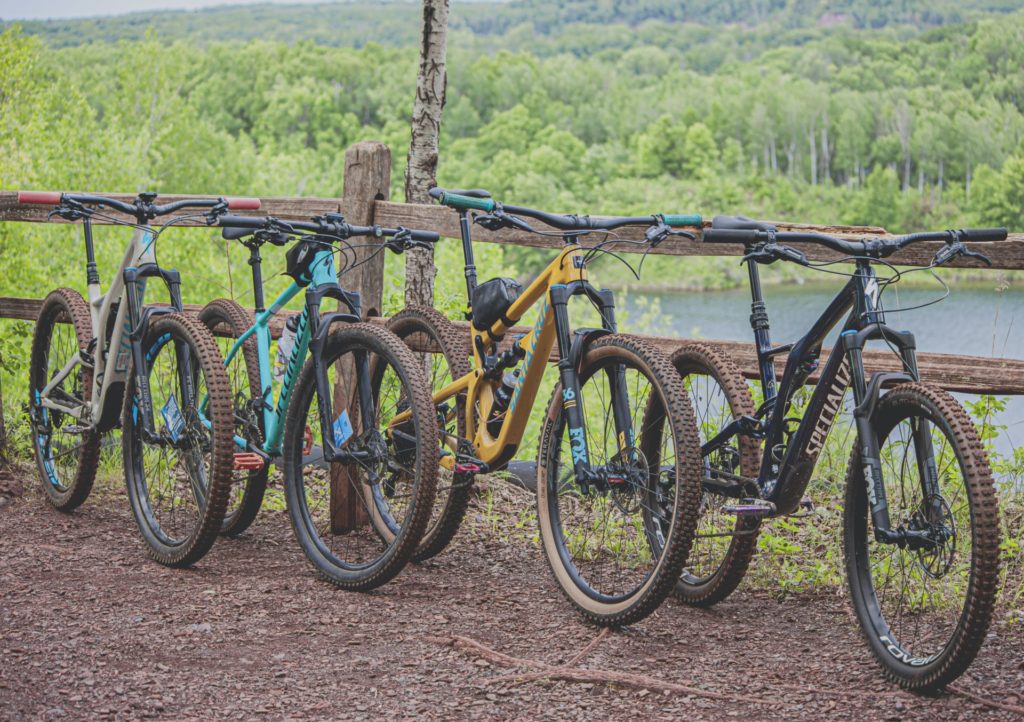
1. Understand Your Bike Wants vs. Needs
Mountain biking is sport that’s evolved so much since I started riding and racing over 15 years ago.
Aluminium frames and components are being replaced with carbon fibre. Bike geometry is getting more and more radical. And prices seem to have climbed sky high.
Personally, I don’t need the latest and greatest frame or suspension kit. Heck, I don’t need carbon everything. But, there were a few things on my must have list that guided my bike search.
I was looking for:
- 29 inch wheels
- Carbon frame
- Fox suspension
- 130-160 mm of travel in the front
- 120-150 mm of travel in the rear
I don’t care much about 2 or 4 piston brakes, fancy cranks and pedals, an 11 or 12 speed drive-train, Shimano or SRAM components… Even a water bottle holder!
That’s waaay too much specificity for my liking, and honestly, it’ll slow down your search. So, have a good conversation with yourself and find out what you really want and need.
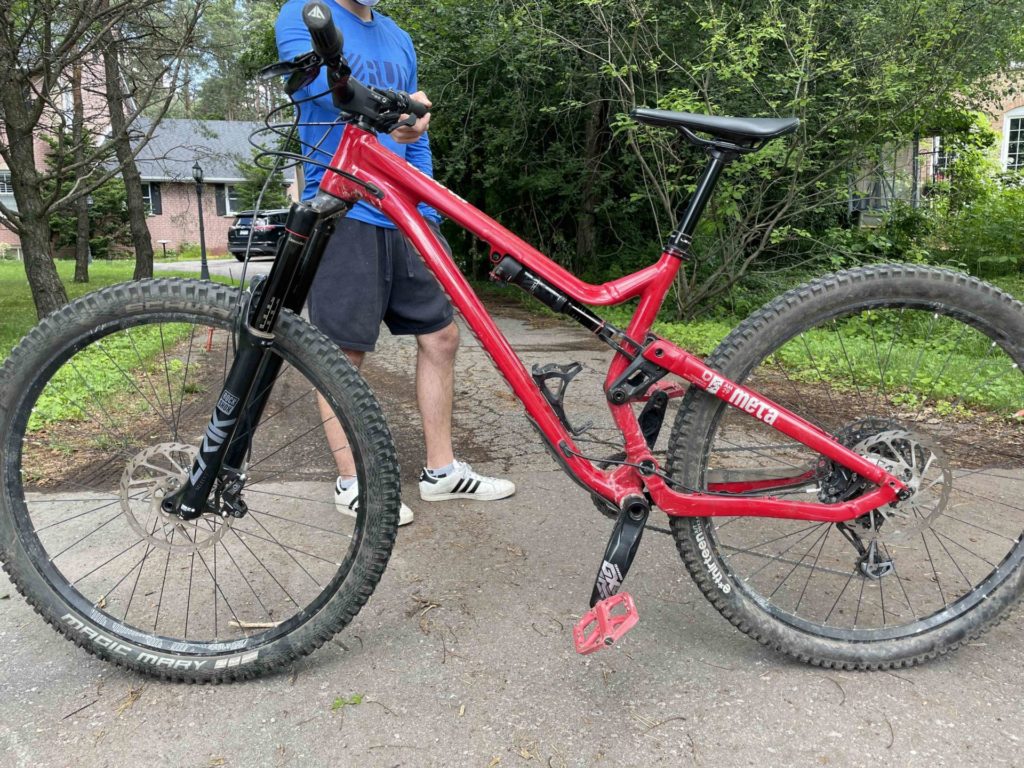
2. Do Your Homework and Test Ride Similar Bikes
If you’re new to mountain biking, it can be a bit overwhelming trying to understand the latest and greatest components and geometry.
“Slack” geometry, stack height, and reach are all very common terms used in biking and they all mean different things. Bike companies attempt to communicate and showcase these numbers on their sizing charts. But looking at numbers and wrapping your head around whether a medium or a large frame is suited for you can be tricky.
Alternatively, a really good way to hone in the bike you ultimately want is by test riding similar bikes. Now, this might be a bit challenging, especially if you live in more rural areas, and of course during a pandemic.
- Visiting a local bike store, or even messaging local sellers to meet up and test ride bikes is a good strategy
This way, you can accurately size up a bike. Personally, after meeting a few local bike sellers, and test riding my friend’s bikes, I was able to definitely select what I’m looking for.
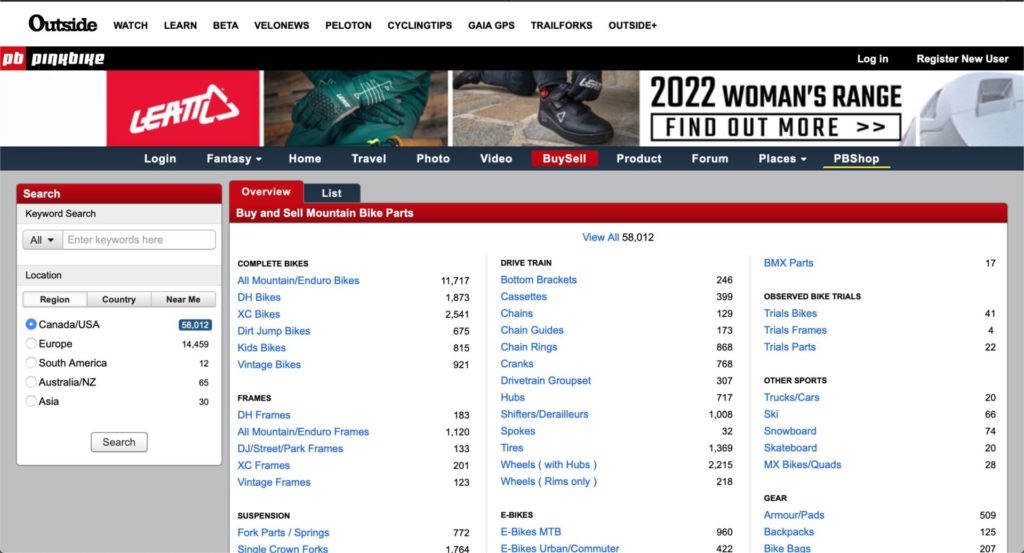
3. Search for a Used Bike in the Right Places
Probably the longest and most tedious part of this entire process is actually searching for a good used bike.
For me, that boiled down to searching on three key platforms, daily and continuously:
- Pinkbike
- Facebook Marketplace
- Kijiji
Facebook market place, and Kijiji are pretty well known. They can be a bit clunky and frustrating to use but you might find something you’re looking for.
If you haven’t heard of PinkBike, you really need to check it out. PinkBike probably one of the best sites on mountain biking on the internet. They regularly post articles and videos on the latest and greatest bikes and bike tech, plus have a massive community of loyal followers.
PinkBike Buy and Sell
I’ve been an active member on PinkBike since 2007. I’ve listed multiple bikes and equipment on the buy & sell page with great success. It’s free to join, so just do it.
Click on the “BuySell” link to direct you to the buy and sell page. From here, you can either navigate to the type of bike you’re looking for under categories and then review all the bikes for sale, or search for something more specific like a bike brand or model.
Typical Bike Ad Post
Here is an example of a typical ad for a used bike. In fact, it’s the exact ad for the bike I purchased! You can see plenty pictures of the bike, key information on the frame size, wheel size, and front and rear travel.
A good seller also includes a lot of description in their post including detailed specs, reason for selling, shipping criteria, payment details, and more.
You can then click on “watch” to save the specific ad on your watchlist, or message the seller directly.
Use Search Filters
One cool thing PinkBike allows you to do is to use filters on the left hand side of the page. This allows you to hone in on the major bike specs and preferences you’re looking for. Plus, you can narrow down by region too.

Saved Searches
Instead of always selecting your specific search criteria on the page every time you visit the buy and sell page, you can actually save your search criteria.
This simple trick can save you a little bit of time and keep your searches consistent with your wants / needs.
Check User Member Date
Keep an eye on the PinkBike user member date. If it’s super recent or matches the date on the post, it might be a scam so tread carefully. I’ve seen incredible deals and raced to message the user only to notice they are brand new to the site.
Then, after a day or so, the ad gets flagged as a scam. Not sure exactly how it works but this has happened to me 2 or 3 times during my search.
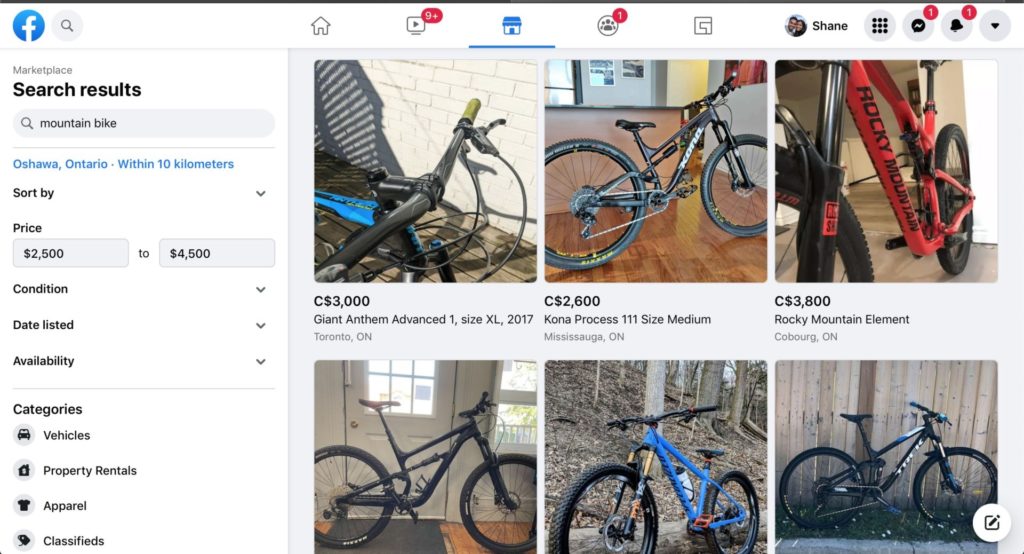
Facebook Marketplace & Kijiji
Now, Facebook marketplace and Kijiji are also good places to look for a used bike. I actually sold my cross-country bike using facebook marketplace relatively pain-free.
Typically, the prices aren’t as standardized as PinkBike, also the search process is nowhere as streamlined. In my experience you either have to search for key words, or brand names to get better search results. Otherwise you’ll have to scroll through endless pages of posts to find suitable bikes.
What I do is focus on a minimum and maximum price that’s reasonable to help filter out the other bikes I’m probably not interested in.
Once I find a bike that fits my criteria, I’ll email the seller letting them know I’m interested.
Speaking of emailing the seller, that’s a perfect Segway because the next important part is…
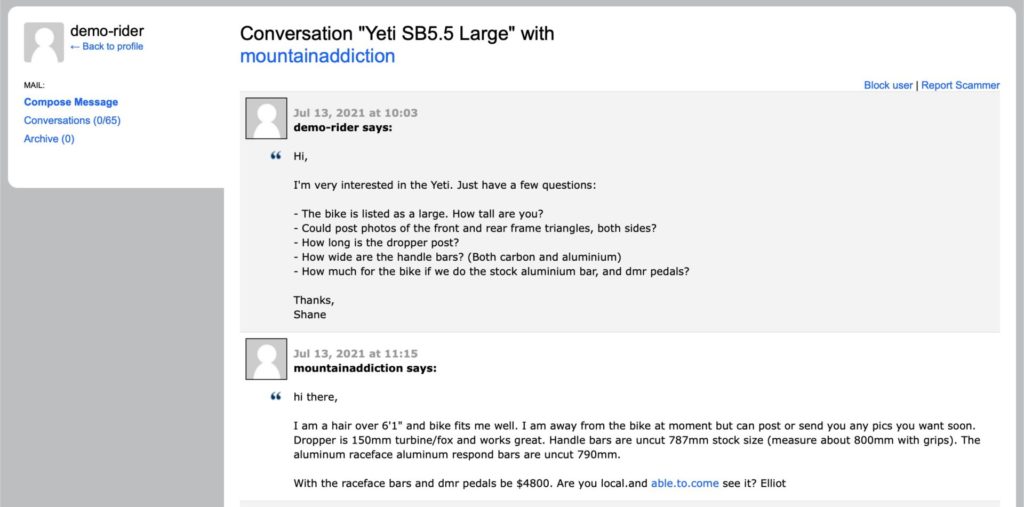
4. What Questions to Ask the Seller
By asking the right questions, you can better gauge the legitimacy of the bike post, build rapport with the seller, and determine if the bike is the right fit for you.
If you’re like me, one of the first questions you need to ask is whether they would be interested in selling (and potentially shipping the bike) out of province. There’s no point wasting their time or your time if the bike will be sold to locals only.
If the ad post is detailed, you won’t necessarily have to ask for the bike specs. However, if some component specs are missed, ask them to confirm the parts.
My standard list of questions include the following:
- The bike frame is listed as a small / medium / large. How tall are you?
- When was the fork / shock last serviced?
- Are there any scratches, or visible damage to the fork or shock stanchions?
- When were the pivots last serviced?
- When was the bike last maintained (derailleur, chain)
- How much tread is left on the front and rear tires
- What are the non-stock bike parts?
- What parts have been replaced? Has anything been replaced under warranty?
- Please send close-up photos of frame (front and rear triangles) from both both sides
5. Negotiating Price
If you’re actually interested in a purchasing a bike that’s up for sale, you’ll ultimately have to start talking about price with the seller. And, there are definitely right and wrong ways of going about this.
First, you should always have a budget, and stick to it. The caveat though is that your budget should be well-informed. You need to study the listed price for similar bikes – better known as doing comparables. Knowing the comparable prices will help you make a more realistic offer, and one that probably won’t be ignored all-together.
Also, you’ll know if a deal is too good to be true, so it might save you from a scam or purchasing a stolen bike.
Negotiating price, especially when the used bike prices can range from $1000 to $10,000 is definitely an asset to have.
Price Negotiating Pro-Tips
- Always ask if the price can be negotiated, even if it says firm on the post, but try not to haggle over anything less than $100.
- If possible, ask if the bike components can be swapped for other components to offset some costs. This was the case for me, since I asked to go for an aluminium bar instead of carbon, and DMR pedals instead of the upgraded pair.
- Don’t let FOMO guide your decision. There will always be an opportunity to buy another bike. I missed out on two deals before find my bike, which was actually the perfect bike for me.
- Take into account shipping costs! For me it would have been an additional $400.
6. Communicating with the Seller
Clear communication is paramount when dealing with a sale. If you feel the communication is not up to your standard, you should pass on the deal. Because, if things go sour, the last thing you want is having to deal with someone who can’t communicate effectively.
Facebook, Kijiji, and Pinkbike have their own internal messaging service. They’re a great way to initiate coms.
If you’re comfortable, moving over to personal emails, or texting can be the next step. The messaging is much quicker so you can move forward with any details efficiently.
I would ask for additional specific photos or video of the bike being used. Ask to see the bike being pedaled, fork and shock being used, dropper post activated, close ups of the frame, tire rims, stanchions, and tire tread.
During my comms, I actually scheduled a Zoom video call with the seller. We spoke for about an hour and he showed me the bike, all the components, and even his bike shop at home. We discussed details about price, and meet-up location (I’ll explain more about this below).
But, during my call, I was more confident that the deal was legitimate and I was willing to purchase this bike.
7. Transferring Funds Safely
When you’re comfortable that the seller is legitimate and this is indeed the bike you want to purchase, you’ll need to transfer funds safely.
To make the sale more legitimate, I created a bill of sale and sent it to the seller via DocuSign. This way I have proof of sale should things go sour.
If there is a lot of interest in the bike, or you really want to secure it, you might be asked to place a deposit which was the case for my bike.
Sending a Deposit
Sending a deposit does two things:
- It proves that you are serious about the bike, and
- It (hopefully) stops the seller from responding to other inquires
Personally, I would be only comfortable sending a deposit after doing a lot of due diligence, as described previously. Only after plenty of emails, calls, and video chats would I recommend putting down a deposit. Otherwise, don’t!
You pretty much have to be 100% comfortable loosing this deposit, so tread carefully. In my case, the seller and I agreed that I send $500 as a deposit, which I did via e-transfer.
Sending the Balance of Funds
For the remaining funds, I would also send two e-transfers but withhold the passwords until the seller met-up with my friend. See, I’m originally from Vancouver but live in Toronto. I have a friend in Vancouver who was willing to drive and meet up with the seller to pick up the bike and hold it for me until I visited later that year.
Our deal was that both parties would meet up in Hope (a city half way in-between), make sure everything checks out, accept the e-transfers, and have the bike exchange hands.
On the day of the transfer, I started a WhatsApp chat with all three parties, and constantly monitored the progress of the transaction. The seller sent photos of the bike in the truck, and my friend sent me updates of where he was. They successfully met up, I sent the e-transfer passwords, the money was transferred, and the bike was loaded into my friend’s car. Success!
Money Transfer Pro-Tips
- Try to use PayPal since they offer buyer protection
- E-transfer are quick and easy, for both parties. But remember, e-transfers cannot be reversed!
- Never send money via western union.
- Also, if a seller asks you to send them bitcoin, it’s probably a scam
- If you don’t have a local friend, call a bike store and see if they can be the middleman
8. Transporting and Shipping a Used Bike
So, now that the bike was purchased, I had to ship it from Vancouver to Toronto. For me, the good news was that I was already traveling to Vancouver a few months after the transfer.
My plan was to package it up myself and include it as checked luggage on my Air Canada flight back.
I sourced a cardboard box and packing supplies from a furniture store and they were happy to let me have as much as I needed for free!
I’ve had previous experience packing a bike, but there are many YouTube tutorials you can reference to help you pack it securely.

Bike Box as Checked Luggage on Flight
The cost and limits for bikes on flights are similar across airlines. Here are the terms for checked bicycles from Air Canada:
Bicycles must not exceed the following limits:
- Maximum weight: 32 kg (70 lb)
- Maximum linear dimensions (length + width + height): 292 cm (115 in)
No overweight or oversize charges apply to bicycles, provided they are within the maximum weight and size limits indicated above.
Bicycles are subject to a fee of $50.00 CA/US (plus applicable taxes) for carriage on Air Canada and Air Canada Rouge flights, as well as on Air Canada Express flights operated by Jazz.
- The fee applies to one-way flights and for each way of travel on round-trip and multi-segment flights
- No other baggage fees apply to bicycles
Shipping a Used Bike
Now, if you don’t plan on flying to the destination for pickup, you’ll need to get it packaged and shipped. You can arrange this with the seller, or ask a bike shop to do it. A bike shop can probably do a better job disassembling and making sure everything is secure.
Shipping a bike via FedEx or Canada Post across Canada or internationally can be very expensive (which is another reason many people opt not to do it anyways). But, another option for shipping a lot of riders use is BikeFlights.
BikeFlights is great since they provide you with a bike box, packing supplies and packing guide. The process is straight-forward, and you can track your shipment with peace of mind.
For me, to ship my bike from Vancouver to Toronto using BikeFlights, and including the required protection insurance, it would have cost around $400.
So, when you’re purchasing a used bike, you’ll have to factor that additional cost into your overall budget.
Hopefully this strategy and the tips mentioned make your next used bike purchase a lot smoother. Happy riding!
This article contains affiliate links, which help support this blog at no cost to you!
